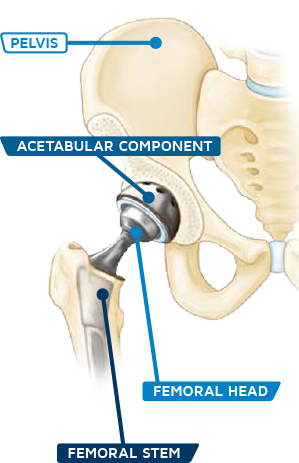
Total Hip Replacement Services
Indications
The primary indication for a total hip arthroplasty is to relieve pain caused by severe arthritis. The destruction of articular cartilage can limit your ability to walk, climb stairs, and perform other functional activities. Articular cartilage damage is caused by inflammation of the joint which eventually causes joint deconstruction. If the pain is very severe, a person may not move that joint like he/she should causing muscle weakness and joint stiffness.
Total Hip Arthroplasty Surgery

The normal hip is a ball and socket joint. The socket is a cup shaped bone on the pelvis and the ball is the head of the femur. The surgeon will remove the damaged ball, which is the upper end of the femur, and then replace it with an artificial joint called a prosthesis. The prosthesis is a metal or ceramic ball attached to a metal stem. A canal is made in the femur bone to allow the metal stem to be inserted into your femur. A metal alloy socket with a polyurethane liner is placed into the pelvis to replace the arthritic socket. This procedure can take 2-4 hours.
Recovery
The recovery process after a total hip replacement varies depending on your previous level of activity, how your body responds to the surgery, and your level of activity after surgery. The majority of people walk with a walker for 2-3 weeks and then move on to a cane until they feel stable enough to walk independently. You will notice swelling of the hip and knee for up to 3-4 months after surgery.
Often, after a total hip replacement, you are referred to physical therapy that is done either in your home if you have difficulty leaving your home or in an outpatient clinic. The therapist will perform an evaluation of your level of function, strength, and range of motion. Based on the evaluation, the therapist will develop exercises and other treatments to help you reach your goals of increased function and decreased pain.
Physical therapy rehabilitation after a total hip replacement usually lasts for 4-8 weeks. Your physical therapist will also help you determine when it is safe for you to start walking without using an assistive device, such as a walker or a cane.
Common and normal recovery signs include bruising around the hip as well as down the entire leg. Bruising can look deep and dark. It might also look yellow or green in color. This bruising can develop as late as 3-5 days after surgery and will resolve with time.
Frequently Asked Questions
Q: Are there any long-term advantages or disadvantages to having a direct anterior hip replacement?
A: Typically, the long-term results of having a direct anterior hip replacement are the same as having a traditional hip replacement (posterior). However, the short-term benefits are what make the direct anterior hip replacement a favored procedure for many hip replacement candidates. Shorter healing times, less pain, and fewer limitations on post-surgery activities are just a few of the short-term benefits of having a direct anterior hip replacement.
Q: Is the direct anterior hip replacement procedure cheaper or more expensive than the traditional hip replacement procedure?
A: The cost of the hip replacement surgery is about the same for both procedures, however, patients may save money if they go the route of having the direct anterior hip replacement procedure done because patients who undergo this surgery typically have a shorter hospital stay and recovery time. As with any medical procedure, costs will vary with each patient and their health care coverage.
Q: How long does the surgery last?
A: Typically, patients are in surgery for about an hour and a half. Surgery may take longer for those with tighter muscles.
Q: Can anyone get a direct anterior hip replacement done?
A: This procedure is not for everyone. The direct anterior hip replacement may not be suitable for people with certain types of bone anatomy, for instance. It is best to talk with a physician to choose which procedure – the direct anterior approach or a more traditional hip replacement – is right for you.
Q: How painful is a hip replacement?
A: After a hip replacement procedure, pain will no longer be achy and arthritic, but rather come from wound healing, swelling, and inflammation. Patients typically report little to no pain around the 2-6 week mark.
Q: What is the hip replacement surgery recovery time?
A: Recovery time depends on a variety of aspects, including the type of procedure performed and the health of the patient, however many patients resume their recreational activities within 12 weeks following surgery. For others, it may take up to 6 months to completely recover.
